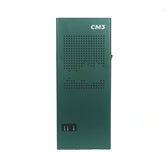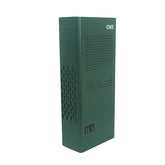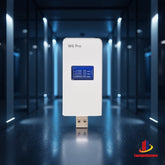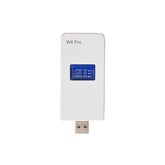Research on common control technology of UAV radio
1. Current status of UAV development and management
my country's civil UAV market has experienced decades of development, and its characteristics have gradually changed from small scale, slow growth, and professional-level orientation to large-scale, fast-growing, and consumer-oriented. In 2011, consumer-grade civilian drone companies represented by DJI rose rapidly and began to occupy a dominant position in the global consumer-grade drone market. From 2014 to 2017, my country's civil drones have continuously received extensive attention from the capital market and public opinion. The Internet Data Center (IDC) predicts that the global drone market will reach more than 3.9 million units in 2019, while my country's drone market will reach more than 3 million units. It can be seen that the control of drones will become a problem that the management department must face.
2. Common technologies of drones
The key technologies commonly used in UAVs mainly include: power technology, navigation technology, communication technology, control technology, computing technology, etc. Closely related to radio management is navigation technology and communication technology.
2.1 Navigation technology
UAV navigation technology is mainly used for UAV positioning, ranging, speed measurement, etc. At present, the positioning technologies adopted by the UAV system mainly include global navigation satellite system positioning (GPS, Beidou, Galileo, GLONASS, etc.), multi-information source positioning and ultra-wideband (UWB) positioning. For example, the UAV can determine its own position by using its own navigation module to receive the navigation signals continuously broadcast by the satellite, and further realize autonomous flight according to the preset path. Ranging technology is mostly realized by one or more methods of ultrasonic, laser, radar and vision. The speed measurement technology can be completed through positioning and ranging technology, as well as built-in gyroscopes, acceleration sensors, etc.
2.2 Communication Technology
The external communication technology of UAV mainly relies on radio technology to realize the information transmission of control link and data link. Usually, the drone receives the remote control signal sent by the operator through the console to fly, and at the same time transmits its own flight status, captured images or videos to the console for reference by the drone operator for flight attitude adjustment or data storage Wait for subsequent operations. The mainstream communication methods are satellite communication, UHF, L and other frequency band over-the-horizon communication, 2.4G/5.8G Wi-Fi direct connection communication, and new-type UAV communication realized by public mobile communication technology. Although UAV communication mostly adopts technologies such as frequency hopping and spread spectrum, due to the long distance between UAV and the operator, the communication signal is weak and susceptible to interference.
3. Technical means of drone control
In recent years, the UAV countermeasure technology has gradually matured, and the development of equipment has become increasingly abundant. The main idea of UAV control is to "discover, locate, and suppress" UAVs, as shown in Figure 1. From these three perspectives, the UAV management and control techniques are summarized for the common technologies of UAVs.
The main idea of UAV control
3.1 Discovery Technology
The discovery of UAVs is the first step in the radio control of UAVs. Only on the basis of accurate discovery and identification of targets, can radio control of target UAVs be carried out in a targeted manner.
In addition to visual discrimination, the most effective direct detection technology is radar detection technology. The detection of UAV targets is achieved by utilizing the reflection of electromagnetic waves when they encounter obstacles during propagation. Radar detection technology usually adopts electronic scanning radar of S, X, and Ku bands, and the effective detection distance can reach 5 kilometers, and it is not affected by the type of UAV. However, this technology has certain defects in the detection of some UAVs, such as UAVs made of wave-transmitting materials (plastic, wood), low-flying, slow-flying, and shuttle between urban buildings. It has poor detection ability and is susceptible to interference from other moving or fixed objects.
Indirect discovery technology, that is, radio monitoring technology, realizes the discovery of the target of the UAV or ground operator by using the radio remote control telemetry signal, flight status information, data transmission and image transmission signals transmitted by the UAV or ground console. Radio monitoring technology usually uses fixed or mobile radio monitoring equipment (including high-sensitivity receiving antennas, broadband receivers, spectrum analyzers, etc.) to identify UAV signals (800MHz, 1.4GHz, 2.4GHz, 5.8GHz control, data transmission and image transmission signal, etc.). The effective detection distance of this technology for UAVs is generally within 2 kilometers, and is not affected by the type of UAVs. Monitoring equipment can be deployed on demand and can detect UAV signals traveling between buildings. But the technology fails when the drone is only flying on a predetermined route, keeping the radio silent.
3.2 Positioning technology
After using radar detection and radio monitoring to find suspected UAV targets, it is necessary to further confirm the target through visual recognition, path recognition and other technologies. After being confirmed as the target UAV, the next step is to locate and find the target, so as to realize the prediction and continuous tracking of the target attempt.
The radio positioning technology uses multiple radio monitoring equipment to find the direction of the target UAV, and uses cross positioning, TDOA positioning and other methods to determine the position, movement direction, speed, etc. of the target UAV, so as to realize the detection of the target UAV. real-time tracking. The UAV data transmission and image transmission module will transmit the data and video information collected by the UAV back to the console or other user terminals through radio signals, so that special monitoring and positioning can be carried out for the UAV's return signal. signal source. Based on the same principle, the positioning of the UAV operator can also be achieved by monitoring the control signal sent by the console to the UAV. It is worth noting that the technology also fails when the drone is only flying on a predetermined route, maintaining radio silence.
3.3 Pressing technology
After the suspicious drone is identified as the target drone, physical destruction, biological capture, and drone jammer can be used to suppress the target drone so that the target drone cannot continue to work. In the working process of the UAV system, there are generally the following situations: one is that the console sends a one-way control link to the UAV; the other is that the UAV receives satellite navigation signals; the third is that the UAV feedback flight to the console data. At least one of one and two exists. According to the working characteristics of the above-mentioned UAV system, targeted suppression technology can be adopted.
Radio jamming suppresses control signals, high-power jamming or decoding takeover of the one-way control link transmitted by the console to the drone. It can make the drone unable to distinguish the control signal, so that it cannot receive the operator's command, enter the safe mode to make a forced landing, return home, or can only receive the command of the controller, and the controller will control it to land to the designated place. Since the target UAV is closer to the radio interference source than the console, the interference suppression effect is better, so this method can effectively prevent the UAV from invading the restricted flight area. However, if the suppression control signal is invalid, it can be judged that the UAV is only in cruise mode, and the next method can be used at this time.
Radio interference suppresses the navigation signal, interferes or deceives the positioning and navigation signals of the satellite broadcast, so that the UAV cannot obtain its current position information or obtains false position information, so that the UAV cannot fly smoothly or even crash or Fly to the designated location. Since most UAVs use navigation technology, this method has a wide range of applications and is easy to operate, and can effectively destroy the UAV cruise state. However, if the suppression of the navigation signal is invalid, it can be judged that the UAV is only in the operator mode, and the previous method can be used at this time.
Radio interference suppresses digital signals, that is, interferes with the data signals fed back by the drone to the terminal, and destroys the data, images, videos and other information returned by the drone, so as to protect privacy and information security. However, this method is more difficult to implement and less feasible.

4. Recommendations for drone control
According to the radio technology used by the drone, it can be controlled in a targeted manner. However, with the continuous development and increase of UAV technology and applications, there are still many difficulties in the radio control of UAVs. Therefore, the following three suggestions for UAV technology control are proposed:
4.1 Combined use of various UAV control technologies
There are still many challenges in the current UAV control technology. For example, UAVs are small in size, can take off and land at any time, are easy to control, and can rely on navigation signals and preset routes to fly autonomously, which makes it difficult to find; There are many kinds of jamming technologies, and the continuous development and upgrading make signal detection and identification more difficult. Due to the difficulty in identifying the target UAV, it further leads to more stringent requirements for the time from discovery to disposal and the suppression effect. Therefore, only using a single UAV discovery, positioning, and suppression technology cannot accurately, effectively and reliably complete the control of the target UAV. The use of a variety of UAV discovery, positioning, and suppression technologies to control UAVs will be the development trend of related work in the future. Through the collaborative work and complementary advantages of various technologies and equipment, the discovery probability of the target UAV can be further improved, the misrecognition rate of the UAV can be reduced, and the interference to other radio equipment and users can be reduced, so as to realize the detection of the UAV. full-time, full-area multi-dimensional identification, real-time tracking, and reliable suppression.
4.2 Explore innovative UAV management and control technologies
Support innovative research on UAV safety improvement, key technology complement, management and control technology application, etc. Optimize traditional UAV control technology, improve aerial radio monitoring methods, and explore new control methods and measures. For example, in terms of active management and control, for cooperative UAVs, the development of light and small air traffic control equipment should be accelerated, and top-down monitoring should be achieved through a friendly approach to protocol control; for non-cooperative UAVs, the focus should be on improving navigation , positioning accuracy, explore other technical blocking means, realize bottom-up discovery, positioning, suppression, and make forced landing, capture or physical destruction of UAVs. In terms of passive control, the drones are prevented from completing related illegal activities by setting up electronic fences, setting up no-fly zones, and interfering with data link transmission. In addition, promote the establishment of a national-level UAV management and control platform, explore ways to combine traditional radio monitoring networks, mobile communication networks, and the Internet, and integrate various management and control methods to strengthen real-time early warning, identification, and monitoring capabilities for UAVs .
4.3 Avoid potential risks of interfering with the suppression process
The application of GNSS is very extensive, such as land and sea transportation, power grid system, telecommunication and mobile communication system, aerospace, weapon guidance and so on. Its timing and navigation and positioning functions provide important support for closely related fields such as economy, society, and national defense. Since the satellite navigation signal on the ground is already very weak, the equipment using satellite navigation is very sensitive to radio interference. Since radio means can suppress and deceive UAVs, it will also cause harmful interference to other related equipment, which will bring some unpredictable security risks. In addition, high-power radio interference to UAVs may also affect the normal use of other legitimate radio services, including other legitimate users within the UAV frequency band and adjacent frequency bands. Due to the lack of relevant legal basis and operational experience, the management department must be cautious in taking corresponding control measures, and make decisions on the basis of full analysis and evaluation, so as to improve the accuracy and quality of the control equipment as much as possible, reduce the control area, and avoid various problems in the control process. a risk.
5. Conclusion
There are many management departments involved in the UAV control work, and the use of technical means to assist the UAV control work should be the responsibility of the radio management department. The radio management department can improve the UAV radio control mechanism, explore efficient UAV control technology, maintain the normalization of UAV radio control, and minimize the impact on the surrounding electromagnetic environment. The competent authorities precisely suppress and effectively manage and control various illegal and illegal drones, and contribute to maintaining the order of air waves and fully safeguarding national social security.













